Mulberries: ad-free FULL Plant Guide
A single Mulberry tree can produce buckets of sweet & nutritious fruit for 100-300 years! Fruit for a lifetime! It’s a LOW-maintenance tree that’s adaptable to many conditions (soil, light, moisture). It is the most underappreciated fruit tree.
Plant Mulberries in rich, well-drained soil and in full sun for the most fruit production. Also, pruning Mulberries is important because they grow quick. Prune ‘strategically’ to assure that you pick buckets of fruit without using a ladder! Everything we’ve learned so far is on this ONE ad-free webpage 😉
However, carefully select the tree’s location. Unpicked berries fall to the ground and will stain sidewalks & driveways.
The Mulberry tree is misunderstood. There are MANY varieties but ONLY TWO Mulberries are native to North America (NA). Some other varieties are invasive!!!
The Red Mulberry (Morus rubra) and the Texas Mulberry (Morus microphylla) are the two species native to NA. The Red Mulberrry is endangered in Connecticut and Massachusetts, and threatened in Michigan & Vermont, according to the USDA. PLEASE plant the Red Mulberry!!
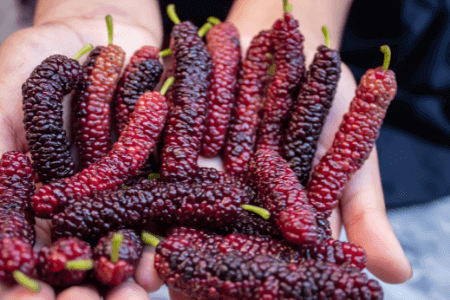
Mulberry Tree Guide on ONE webpage!
On this page:
1. Mulberry Tree Fact Sheet.
2. Types of Mulberry Tree.
3. Mulberries in landscaping and urban gardens.
4. Mulberries’ medicinal qualities, recipes and eating fresh Mulberry fruit (fresh, compote, jam, etc.).
5. Commercial viability.
6. Mulberry Tree Guide for Care and Maintenance.
7. Propagating the Mulberry tree.
8. Mulberries we grow organically at HEPPY™!
________________________________________
see our list of 400 edible plants
YouTube channel (please subscribe)
YouTube channel JUST for MULBERRIES (please subscribe)
Mulberries Tree Fact Sheet:
Use in garden design, permaculture, and organic gardening
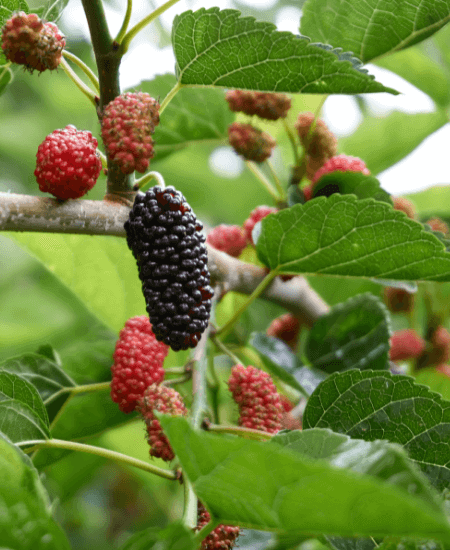
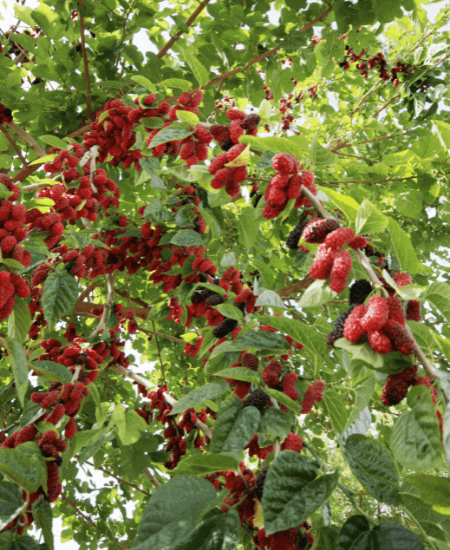
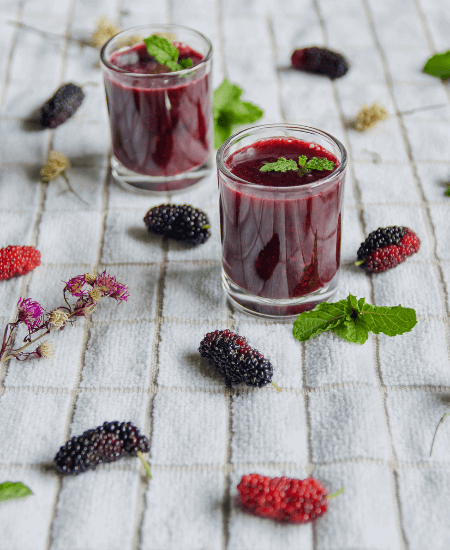
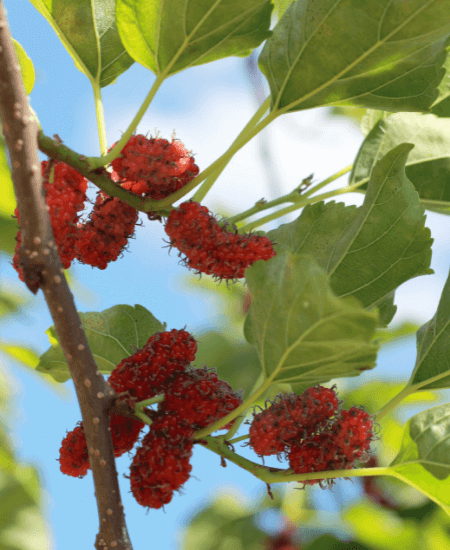
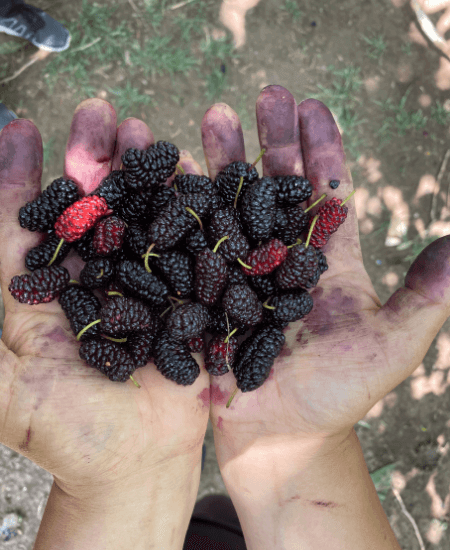

Mulberry Tree Fact Sheet
Zone: 4 to 9 (individual varieties vary slightly)
Height: 20 – 50 feet
Native: ONLY the Red & Texas varieties are native to North America)
Bloom Time: March – April
Bloom Color: green (not really a ‘bloom’ — she’s different 😉
Fruit Maturity: June – July
Self-fertile: mostly yes but some may not be (see immediately below*)
Sun: full (will tolerate shade but produces less fruit)
Water: medium (will tolerate drought and heat)
Soil: rich organic (preferred)
Maintenance: forgiving once established
Growth Rate: fast
Deciduous or evergreen: deciduous
Edible¹: berries (more information is below)
Medicinal²: yes (discussed below)
Commercial viability: strong (discussed below)
Family / Genus: Moraceae / Morus
Remarks: prolific producer; LOW maintenance, huge fruiting shade tree; pest and disease resistant; usually self-fertile
* SELF-FERTILITY: Mulberries are either monoecious (male and female flowers on the same plant [self-fertile]) OR dioecious (with male and female flowers on separate plants [not self-fertile]).
Types of Mulberries
Mulberries: Native and Non-native Varieties
HEPPY™ is bias towards native Mulberry trees for two reasons:
1. the native Red Mulberry is endangered by non-native Mulberries. the White Mulberry (Morus alba) is considered a “Midwest Noxious Weed”. it hybridizes with the Red Mulberry and spreads a harmful root disease to it. the Paper and Black Mulberries either hybridizes the Red or displaces native vegetation.
2. species to North America are MOST adaptable and sustainable. we LOVE well-adapted non-natives (the Sweet Scarlet Goumi, Green Tea plant, etc). but for Mulberries, HEPPY is advocates planting our native ‘girls’ — the Red and Texas mulberries!
Mulberries: Major Species of Mulberry Trees
Red Mulberry (Morus rubra)
native to North America, the Red Mulberry produces excellent fruit quality. our red mulberry fruit tastes like raspberry. fruit size is not as large as White & Black Mulberry cultivars. VERY adaptable (to soil, light, moisture conditions).
at least 8 American Indian tribes used Red Mulberry for food, medicinally, or as a tool. it’s also an excellent source of wildlife food. the color of ripe fruit is usually dark — dark purple or black.
it grows native from southeastern Canada to southern Florida (zones 4-8).
Texas Mulberry (Morus microphylla)
native to North America, the Texas Mulberry tree is likely the shortest at maturity — 20′ tall at maturity produces. produces very sweet fruit. fruit size is not as large as White & Black Mulberry cultivars.
American Indian tribes ate the fruit fresh, and pressed it into pulpy cakes, dried and stored as winter food. it’s also an excellent source of wildlife food. the color of ripe fruit is usually dark — dark purple or black.
it grows native from Arizona to Oklahoma, through Texas and Northern Mexico (zones 5-9). our Texas Mulberry tree is thriving in humid Maryland conditions (zone 7).
Black Mulberry (Morus nigra)
Black Mulberry is native to western Asia and has been grown for its fruits in Europe since before Roman times. it’s the longest lived Mulberry tree — known to produce fruit for hundreds of years. but it’s likely the least cold tolerant (perhaps on-par with the Paper Mulberry). plant zone tolerance varies. it may be cold hardy to zone 5 or zone 7 (depending on source). this is the optimal tree to grow in Asia for fruit production.
there are several popular Black Mulberry cultivars. ‘Black Persian’, ‘Black Beauty’ and ‘Noir of Spain’ are commonly sold.
Paper Mulberry (Broussonetia papyrifera)
Paper Mulberry is native to Asia. it’s likely the fastest growing Mulberry tree. it is not cold tolerant (on-par with the Black Mulberry). plant zone 6-9.
it is invasive in the States AND in several other countries! also, its pollen appears to promote allergic illness; it grows vigorously and displaces native plants through competition and shading; and its shallow root system makes it susceptible to falling over (by wind, moist soil, etc.). this tree is a mess. please do not plant the Paper Mulberry.
White Mulberry (Morus alba)
“Midwest Noxious Weed: Do Not Plant” is the introduction by the Missouri Botanical Garden.
the White Mulberry is native to China. it’s likely the most heavily cultivated and sold tree in North America (ie, cultivars of the White Mulberry). fruit size is large and fruit production is high. this is the optimal tree to grow in Asia for medicinal qualities (leaves, root bark, stem and fruits).
White Mulberry tree leaves have been used in China since at least 2600 BC. it’s the primary diet for silkworms. trees were introduced into North America in colonial times to establish a silk industry. however, the industry never materialized. instead, the White Mulberry tree escaped cultivation and naturalized in fields, waste areas, forest margins and along roads throughout much of the U.S. this tree has also been planted in various areas for erosion control and windbreaks.
White Mulberry hybridizes with native Red Mulberry and threatens to replace it. do NOT plant Morus alba where you have a native Red Mulberry population. Morus alba is cold tolerant (zone 4-8), which is another way it ‘reaches’ the Red Mulberry.
Other types of Mulberries
Himalayan (Morus laevigata), Pakistan and Tibetan Mulberries are confusing. Latin names overlap; I’ve found Morus macroura and Morus serrata to describe all three. These varieties grow Central Asia and the Middle East. Korean Mulberry (Morus australis) is yet another variety.
Pakistan Mulberry
this Mulberry illistrates the confusion in identifying some species. an online search found species-name, Morus alba, Morus alba x rubra, Morus macroura, and Morus nigra. all that for the Pakistan Mulberry?
Mulberry Fruit
Variety of fruit colors
black-colored fruit grows on the White Mulberry (Morus alba) tree, AS WELL AS pink, purple, red or white fruit. Black Mulberry (Morus nigra) almost always produce black-colored fruit. Red (Morus rubra) and Texas (Morus microphylla) mulberries produce dark red, purple, or black colored fruit. the Paper Mulberry (Broussonetia papyrifera) has reddish purple to orange colored fruits.
Black
Virtually all Types of Mulberries produce black colored fruit. Black Mulberry (Morus nigra) almost always produce black colored fruit.
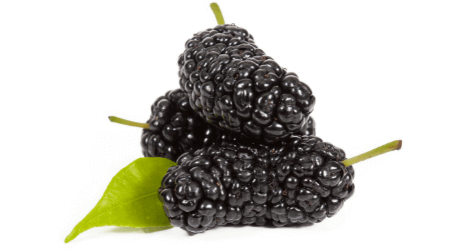
Red
several Types of Mulberries produce red or reddish colored fruit. primarily, the White (Morus alba) and Red (Morus rubra) mulberries.
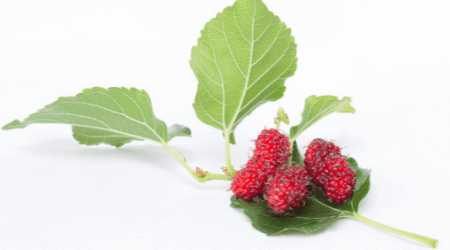
White
White Mulberry (Morus alba) produce black, pink, purple, red, or white colored fruit.

Mulberries in Landscaping and Garden Ideas
Mulberries tolerate heat, humidity, drought, various soils, and urban pollution. they are deciduous trees, and grow fast. most produce fruit; Mulberry fruit stain concrete (hard) surfaces.
in North America, p.l.e.a.s.e. consider planting the two native mulberries: Red Mulberry (Morus rubra) and the Texas Mulberry (Morus microphylla).
Landscape Architecture
in landscape architecture, Mulberry trees need space. they grow tall, their roots are vigorous, and ~95% produce buckets of delicious fruit. however, the fruit stains what it touches.
keep the tree away from sidewalks, parking spaces, septic drain fields (roots) — things you don’t want to have stained or plugged.
Mulberries can be pruned in any manor and shape or, allowed to develop a large, tall crown. the leaves are large so the shade it produces is excellent. the “Red mulberry has a short trunk and stout, spreading branches….”, so training the limbs to grow the desired height and direction is easy. these are LONG-lived trees.
it is an excellent, reliable, productive, and low-maintenance fruit tree. mindfully select its location.
Garden Ideas
the Red Mulberry is incredibly hardy. it grows in part shade, although planting it in full sun will provide more fruit. tolerate many soils but grows best in well drained organic soil. use something similar to our classic 5’ x 5’ x 2’, highly organic tree plot design. create the plot once (invest your time) and enjoy the fruit for a lifetime.
Red Mulberry tolerate zone 4. however, the Texas Mulberry is not as cold-hardy. zone 5 (which excludes about 5 continental States). the two varieties grow fast and are non-invasive Mulberries.
most Mulberry tress are self-pollinating. mulberry fruit are almost always very dark when ripe. Red Mulberry fruit is longer, thinner and more firm than the black mulberry. the fruit flavor is referred to as a delicious tangy-sweet cherry-like flavor. our Reb Mullbery fruit tastes like a sweet raspberry. the fruit’s seeds are inconspicuous (like a strawberry – the “seeds” are so small they are irrelevant when eating, juicing or baking with them).
NOTE again that Mulberries producer a lot of fruit. they should be planted away from sidewalks and driveways.
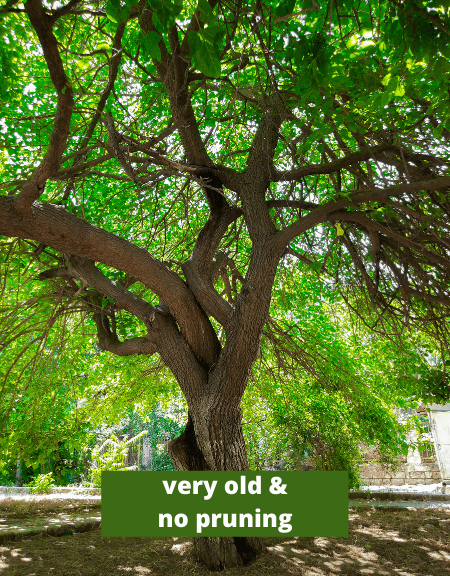

How Mulberries are Eaten and Used Medicinally
1, 2 HEPPY cannot take any responsibility for any adverse effects from the use of plants. Always seek advice from a professional before using a plant for food or medicinally. This information is intended for educational purposes only and should not be considered as a recommendation or an endorsement of any particular medical or health treatment.
Edible fruit
ripe fruits are juicy and sweet and, mature trees provide HUGE amounts of fruit. the fruit can be eaten fresh off the tree, dried or cooked (pies or preserves). Mulberries have antioxidants such as Anthocyanins, Cyanidin, Rutin, Chlorogenic acid, and Myricetin. Mulberries are rich in vitamins and minerals such as Vitamin C, Iron, Vitamin K1, Vitamin E, and Potassium.
Recipes

Medicinal Plants and Herbs — medicinal qualities
medicinally, the “Red Mulberry was used by several Native American tribes to treat a variety of ailments. The sap was used to treat ringworm (Foster and Duke 2000). The Cherokee made a tea from the leaves of the plant for treatment of dysentery, weakness, and difficulty urinating (Hamel and Chiltoskey 1975). The Comanche used the fruit of the red mulberry as a food source (Carlson and Jones 1940, Moerman 1998),” according to a USDA Plant guide.
PubMed research found that, “Leaves from different species of Morus were found to be significantly different [and that] phenolics, flavonoids and antioxidant activities are considerably affected with variety of plant chosen…M. rubra [Red Mulberry] can be investigated for its nutraceutical [health-giving / medicinal benefit] applications. On the other hand, a high amount of phenolics, DPPH radical and ABTS radical cations scavenging potential suggest the superiority of M. nigra [Black Mulberry] over the other species regarding their disease preventive potential. A Comparative Study of Antioxidant Potential of Leaves from Three Varieties of Mulberry.
also, Mulberries have been “used medicinally in Traditional Chinese Medicine including the leaves, root bark, stem and fruits. In East Asia the leaves have been an important herbal medicine for treatment of cold, fever, headache, cough and rheumatic diseases for thousands of years. Extracts or constituents of M. alba [White Mulberry] leaves were reported to possess anti-inflammatory, antioxidant, antiobesity, antidiabetic, and hypolipidemic properties.” however, the White Mulberry is consider a noxious weed in North America’s Midwest.
HEPPY will explore how the the native Mulberry trees are edible and medicinal, and will add content as we learn / verify!
Mulberries Commercial Products — Mulberry Fruit and Mulberry Trees
the commercial viability is strong. pick-your-own farms; food cottage and farmer’s market products (fresh, jams, etc) are easily possible with a highly versatile, low maintenance Red Mulberry. what this tree needs is some space; the Red Mulberry grows so large, and fruits so prolifically, that providing the tree with space is essential to harnessing its commercial potential.
Mulberries at the farmers' market or in the cottage food industry

ripe fruits are juicy and sweet and, mature trees provide HUGE amounts of fruit. the fruit can be eaten fresh off the tree, dried or cooked (pies or preserves).
ALERT: fresh fruit must be transported immediately. the fruit does NOT transport well unless care is taken in the process.
Sell Mulberries as a superfruit. Mulberries have antioxidants such as Anthocyanins, Cyanidin, Rutin, Chlorogenic acid, and Myricetin. Mulberries are rich in vitamins and minerals such as Vitamin C, Iron, Vitamin K1, Vitamin E, and Potassium.
Mulberry tree leaves are promoted online as a health food. Mulberry leaves DO have a positive history in China. however, leaves from different species of Mulberries were found to have significantly different phenolics, flavonoids and antioxidant attributes. and, sales are unregulated.
Commercial or private landscaping
Mulberry Trees are referred to as a “handsome” plant. they fit any backyard and front yard landscaping ideas as long as there is ample space.
sell Mulberry trees as a single shade tree, fruit trees, or a tree to produce habitat and food for wildlife. this is a well-known, desirable tree.
Mulberry trees are easy to trim. make archways or other exotic shapes. imagine a fruiting archway!
Weeping Mulberries, 'Pendula' vs 'Chaparral'
the Weeping Mulberry tree is considered a dwarf tree.
Weeping Mulberry ‘Pendula’ PRODUCE fruit and the Weeping Mulberry ‘Chaparral’ does NOT produce fruit. the ‘Chaparral’ is the ideal plant to grow along sidewalks.
i see conflicting information about tree height. the ‘Chaparral’ appear to grow 6-10 feet tall (2-3 meters) while the ‘Pendula’ may grow to 20 feet tall (6 meters)!
the Pendula and Chaparral grow into a distinct, umbrella-like
architectural form due to its long weeping branches. they develop a dense canopy.
subscribe to our YouTube channel and follow us as we grow our Mulberries. we grow 4 varieties of Mulberries at HEPPY™. use our trees as an example for YOUR commercial or private landscaping ideas!
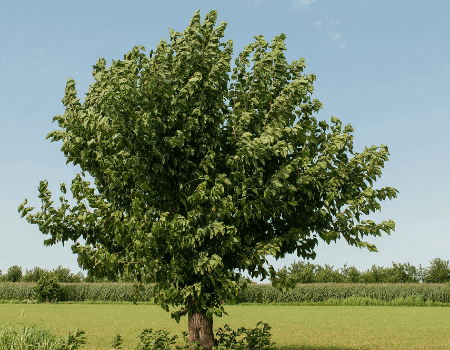
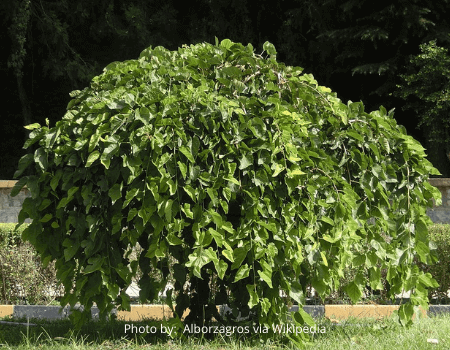
Mulberry Tree Guide to Care and Maintenance:
growing, pruning and harvesting
Mulberry trees are adaptable and versatile.
optimal growing conditions are: well-drained soils with high organic matter, and full sun. medium amount of water until the tree is established (watering is dependent on location).
Soil
Mulberry trees grow in just about any soil. however, soil with organic material encourages stronger / faster growth. HEPPY™ uses super high organic material. our Mulberries exploded with growth!!
Sun
Disease and Pests
No serious insect or disease problems.
Mulberry Tree Pollination
this is a VERY confusing topic. we’ve had our Red Mulberry self-pollinate (Monoecious). but, i’ve read, that some Reds do not self-pollinate (Dioecious).
it gets weirder: some dioecious Mulberry trees may change from one sex to another.
Mulberries pollinate by wind. it will fruit if your tree is self-fertile. so what to do? we advocate buying trees of fruiting size. that’s usually a tree in a 3-5 gallon pot and/or, at least 4-5 feet high. you should see fruit develop by April-May.
Pruning the Mulberry Tree
prune the Mulberry tree aggressively IF you want to pick a lifetime of fruit WITHOUT using a ladder.
much of this section follows our “develop a canopy…pick fruit from branches just above your head” technique. alternatively, pruning is a no-brainer. prune each winter when the tree is dormant. remove broken or ill-looking branches to keep your Mulberries healthy! this tree can withstand heavy pruning if done when she’s dormant.
Pruning
started the process of training / shaping as early as possible. a straight trunk is essential.
we had to straighten the tree trunk of our ‘lil Red Mulberry (Morus rubra). here’s one of my first vid’s — straightening our ‘lil Red Mulberry we named, Forrest Gump 😉
the Red Mulberry grows to 50 feet! so begin by selecting the best limbs growing in four opposite direction. these are your ‘anchor’ limbs. keep 2-4 additional limbs as fallback — as secondary limbs in case the four primary limbs don’t grow well.
shape, shape and shape your Mulberries. either shape ’em or get a tall ladder.
HEAVY pruning should be done when the tree is dormant. pruning new growth is best performed in late Spring and late Summer.
in our landscape architecture, our Mulberries are on the northern edge. they full sun and, send its fruiting limbs in the exact location — height and direction — we want.
Harvesting
our young Red Mulberry started fruiting in 2021!!
pick Mulberries when they’re (typically) jet-black in color. Mulberry fruit some in a variety of colors. white, white-purple, purple, red, and black. typically, it’s black. no matter the color, the fruit should be sweet. any tartness is a signal that you’ve picked a little early.
Propagating Mulberries:
cuttings, division, grafting, layering and seeding
Propagating the Mulberry Tree
Mulberries are easily propagated from cuttings. layering may also work. however, propagation by seed seems impossible for the species we grow. i don’t see seeds!
propagation by cuttings has many advantages. if rooting is successful, then the new tree will be at least 12″ tall. that’s a great jump start.
HEPPY™ will experiment with propagation by cuttings in the near future. volunteer at, or donate to HEPPY to move this project along. the Red Mulberry (Morus rubra) and Texas Mulberry (Morus microphylla) are valuable species to North America.
Propagation Protocol: Morus rubra
Mulberries Growing at HEPPY™

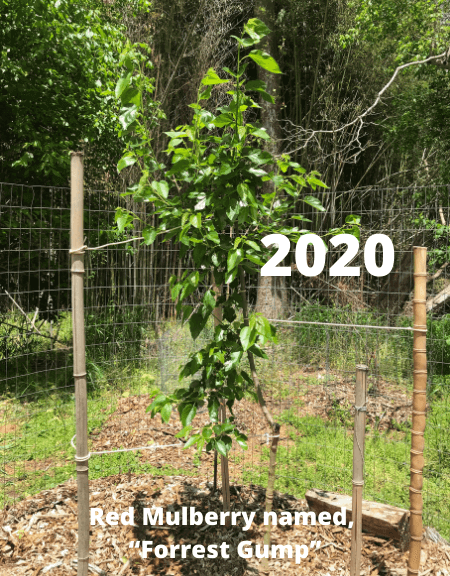
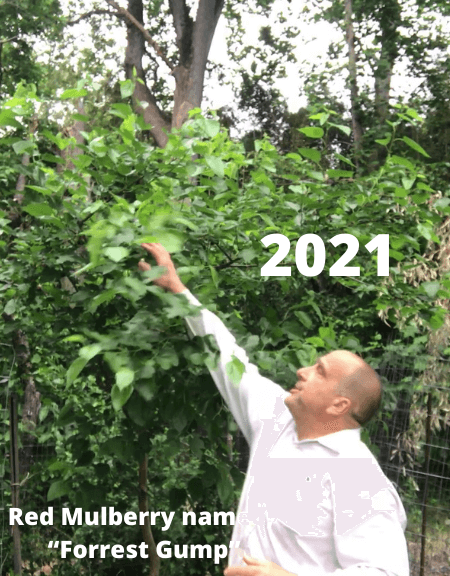
we planted the two species native to North America. follow the our Mulberries over time!! please subscribe to our YouTube Channel
Red Mulberry (Morus rubra)
our Red Mulberry tree is named, “Forrest Gump”! he was hobbled by a crooked trunk from the beginning. then, serious deer predation one year.
we purchased our Lil’ Fella from Peaceful Heritage Permaculture Fruit Nursery in July 2018. he was planted in March 2019.
in terms of landscape design, the location of our Red Mulberry is in full sun, and is on the on the northern edge of our planting area. this allows the tree to grow tall and not create shade for our other fruiting plants.
also, planting along our property’s edge allows falling fruit to be a non-issue. in fact, “Forrest” was planted it along our creek. the Red Mulberry has vigorous roots that will anchor the soil along a creek-bank.
Maryland Department of Natural Resources writes:
• The wood is resistant to decay and often used to make fence posts.
• The Choctaw Indians wove cloaks from the fibrous inner bark of young mulberry shoots
our harvest: we harvested our first bowl of fruit in 2021. sweet and juicy like a blueberry is juicy. the fruit tasted like raspberry but with no tartness.
Texas Mulberry (Morus microphylla)
the Texas Mulberry is also called the Littleleaf Mulberry and Mountain Mulberry.
we purchased the Texan from Natives of Texas in Nov 2020. he was planted in March 2021. our Texas Mulberry tree is unnamed!!
here’s our YouTube vid of our big 24-plant purchase in late 2020.
in terms of landscape design, the location of our Texas Mulberry is in full sun, and is within our general planting area. Texas Mulberries grow to about 20 feet. it’s grows to the shortest height of all Mulberries.
it’s planted in optimal conditions: well draining high organic soil in full sun. the tree has exploded with growth.
Southwest Desert Flora writes:
• the Texas Mulberry is relatively rare in the U.S. where it grows in AZ, NM, OK. and TX. in Arizona it is found in the northern, central and southern parts of the state.
• the Texas Mulberry is used in for culinary purposes. the Apache, Chiricahua & Mescalero made bread & cakes where the fruit is pressed into pulpy cakes, dried and stored, and by the Apache & Mescalero also as food for sauces and relishes.
• she found in elevation: 3,500 to 5,000 feet, 500 to 6,500 feet in California.
• habitat preferences are along streams, canyons and limestone slopes.
• species synonyms: Morus confinis; Morus crataegifolia; Morus grisea; and Morus radulina
our harvest: a little fruit developed in 2021. fruit seems to develop a little after the Red Mulberry.
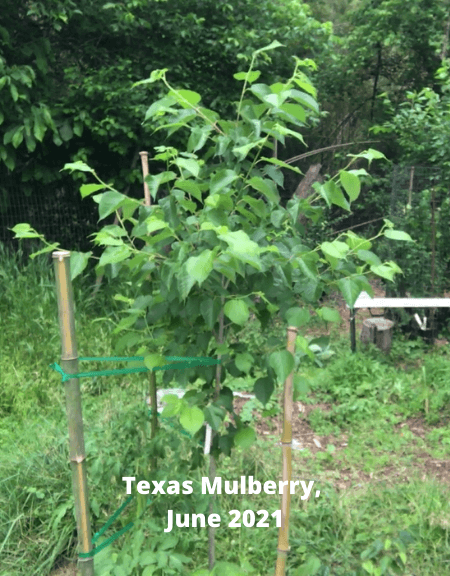

Pakistan Mulberry (Morus alba ' Pakistan')
our Pakistan Mulberry tree unnamed 🙁 we purchased her from Whitman Farms in 2022. we up-potted her to a 3 gallon pot.
species name: this species is VERY confusing. i found four species: Morus alba; Morus alba x rubra; Morus macroura; and Morus nigra. Whitman Farms sells their Pakistan Mulberry as a Morus alba.
plant zone: this is NOT a cold-tolerant tree. i recommend zone 7-10. the Pakistan Mulberry is commonly advertised as a “perfect for southern regions” tree. however, i see zone 6 and the upper (northern) limit. be very cautious planting in zone 6.
tree height: 25 to 50 feet depending on online source. (7.5 to 15 meters.)
fruit size: 4 to 6 inches depending on online source. (10 to 15 centimeters.)
the fruit is “delicious and non-staining.” we look forward to eating TONS of Pakistan Mulberry fruit.
according to California Rare Fruit Growers: the Pakistan Mulberry originated in Islamabad, Pakistan. Extremely large ruby-red fruit 2-1/2 to 3-1/2 inches long and 3/8 inch in diameter. Flesh firmer than most other named cultivars. Sweet with a fine balance of flavors. Quality excellent. Tree spreading with large heart-shaped leaves. Recommended for the deep South and mild winter areas such as southern California, but usually performs satisfactorily in cooler areas.
Weeping Mulberry (Morus alba 'Pendula')
we purchased the Weeping Mulberry ‘Pendula’ from Whitman Farms in 2022. we up-potted her to a 3 gallon pot. Weeping Mulberry grow in zones 4-8, and prefer full sun. they tolerate part shade. they tolerate heat, drought and a wide range of soils. Weeping Mulberry grow somewhat gnarled branches that ‘weep’ to the ground.
the ‘Pendula’ Weeping Mulberry is a dwarf! it fruits. it produces a small fruit that resembles raspberries. i read that they have a bland to slightly sweet taste.
the ‘Chaparral’ Weeping Mulberry is also dwarf but does NOT fruit. ‘Chaparral’ is the variety to grow along sidewalks.
tree height: Weeping Mulberry typically grow to 6-10 feet tall (2-3 meters). however, they may get 20 feet tall (6 meters)! i see conflicting information for the tree’s height.
in terms of landscape design, the location of our Weeping Mulberry is in part sun, and where it’s easily seen.
here’s our 2022 YouTube vid introducing the Weeping and Pakistan Mulberries to HEPPY™.

Growing Morus alba in Maryland. NOT a HEPPY™ thing to do?
Whitman Farms sells the Pakistan Mulberry, Morus alba. yup, the very White Mulberry which ain’t exactly the perfect match for Maryland, and our Red Mulberry. i write this because we’re a no-BS operation. i’ll plant our Pakistan Mulberry far away from our Red, and down-wind. it’s not perfect, we’re we’ll use our judgement. also, we do NOT have a native Red Mulberry population in our region. well, that’s my position now, in early 2022.
References
these are the primary resources :
Missouri Botanical Garden: [Morus]
USDA PLANTS Database: [Morus]






